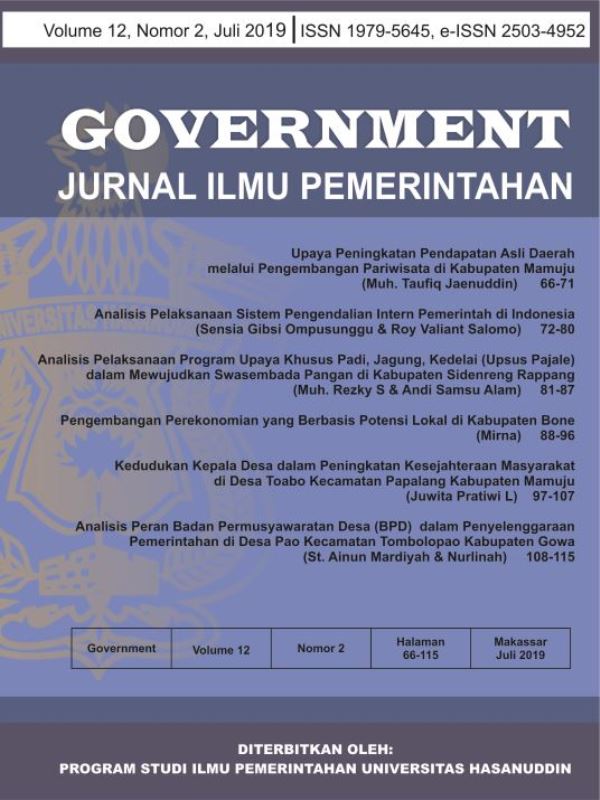Analisis Pelaksanaan Sistem Pengendalian Intern Pemerintah di Indonesia
Keywords:
control, government internal control system, policyAbstract
Law Number 1 of 2004 concerning State Treasury regulates the President as the President of Government and regulates the Government's Internal Control System in Indonesia. In 2008, the Government of Indonesia issued Government Regulation Number 60 of 2008 concerning the Government's Internal Control System. The Government Internal Control System (SPIP) implemented in Indonesia was adopted from the internal Control model made by COSO in 1992. SPIP consists of five elements, namely: (1) Control Environment, (2) Strengthening Assessment, (3) Climate Control, (4) Information and communication and (5) Monitoring. Government Regulation Number 60 of 2008 has been approved for 10 years, the regulation applies. However, the policy contained in Government Regulation Number 60 of 2008 has not been implemented in governance in Indonesia. This can be seen from the evaluation of the government's internal control system carried out by the Financial and Development Supervisory Agency until March 2018 which shows the maturity level of the Government Internal Control System which is still far from the target with the development of Institutions still below level 3 or far from level 5 (optimum level) and weaknesses of the Government's Internal Control System found by the Supreme Audit Agency in the 2015-2017 audit..
References
Andersen, E.S., dan Jessen, S.A. (2003) Project Maturity in Organizations. International Journal of Project Management, 21, 457-461;
Arif Hadianto. (2017). Analisis Kebijakan Penyelenggaraan Sistem Pengendalian Intern Pemerintah dalam Perspektif Content dan Context of Policy (Studi Kasus Kota Tegal dan Kabupaten Tegal). Disertasi. Universitas Indonesia;
Anggella Amudo dan Eno L. Inanga (2009). Evaluation of internal control systems: A case study from Uganda, International Research Journal of Finance and Economics;
Bartol, Kathryn M. et.al. (1996). Management: A Pacific Rim Focus. Sydney: McGraw- Hill Book Company;
Coderre, David. (2009). Internal Audit Efficiency through Automation. John Wiley & Sons, Inc., Hoboken, New Jersey;
Commitee of Sponsoring Organizations of the Treadway Commission. (COSO). (1992). Internal Control-Integrated Framework. Durham: United State
Eric G Flamholtz. 1996. Effective Management Control: Theory and Practice. Kluwer Academic Publisher. Netherland;
Grindle, Merilee S. (1980). Politics and Policy Implementation in Third World. New Jersey: Princeton University Press.
Ikhtisar Hasil Pemeriksaan Semester (IHPS) I BPK Tahun 2015-2017;
Konrath, Larry F. (1996). Auditing: Concepts and applications, a risk analysis approach. (3rd ed.). Minnesota: West Publishing Company;
Moleong, (2011); Metode Penelitian Kualitatif. Bandung: Remaja Rosdakarya
Nurhayanto. (2013). Fraud Auditing. Jakarta. Lembaga Pengembangan Fraud Auditing;
Pfister Jan A. (2009). Managing Organiztional Cultur for Effective Internal Control from Practice to Theory. Springer. Zurich;
Pickett, K. H. Spencer. (2010). The Internal auditing handbook.West Sussex, England: John Wiley & Sons;
Sawyer, L.B., Dittenhofer, M.A., dan Scheiner, J.H.. (2006). Audit Internal. Buku 3, Edisi 5, Jakarta: Salemba Empat.
Simon, Mark R., (1997). COSO-Based Auditing, Internal Auditor, 69-73;
Stoner, James A.F., Freeman, Edward R. & Gilbert, Daniel R., Jr. (1995). Management. Engelwood Cliffs: New Jersey: Prentice-Hall, Inc.
Sujamto. (1983). Beberapa Pengertian di Bidang Pengawasan. Ghalia Indonesia: Jakarta;
Triyulianto, Tony. (2008). Sistem Pengendalian Intern Pemerintah (SPIP) bersama kita bisa menyonsong masa depan BPKP yang lebih cerah. Bulletin Perwakilan BPKP Provinsi Sulawesi Selatan, 4, 3-10;
Walsh, J. and J. Seward (1990). On the efficiency of internal and external corporate control mechanisms. Acad. Manage. Rev. 15, 421-458. Warner, J. (1977).
Panggabean, Maralus. (2014). Analisis Pengaruh Sistem Pengendalian Internal terhadap Pengawasan Internal alam Perspektif Chaos Theory di Kementerian Pendidikan dan Kebudayaan. Disertasi UI: Jakarta;
Pusdiklatwas BPKP (2016). Modul Penilaian Maturitas Sistem pengendalian internal Pemerintah. Pusat Pendidikan dan Pelatihan Pengawasan BPKP. Bogor;

